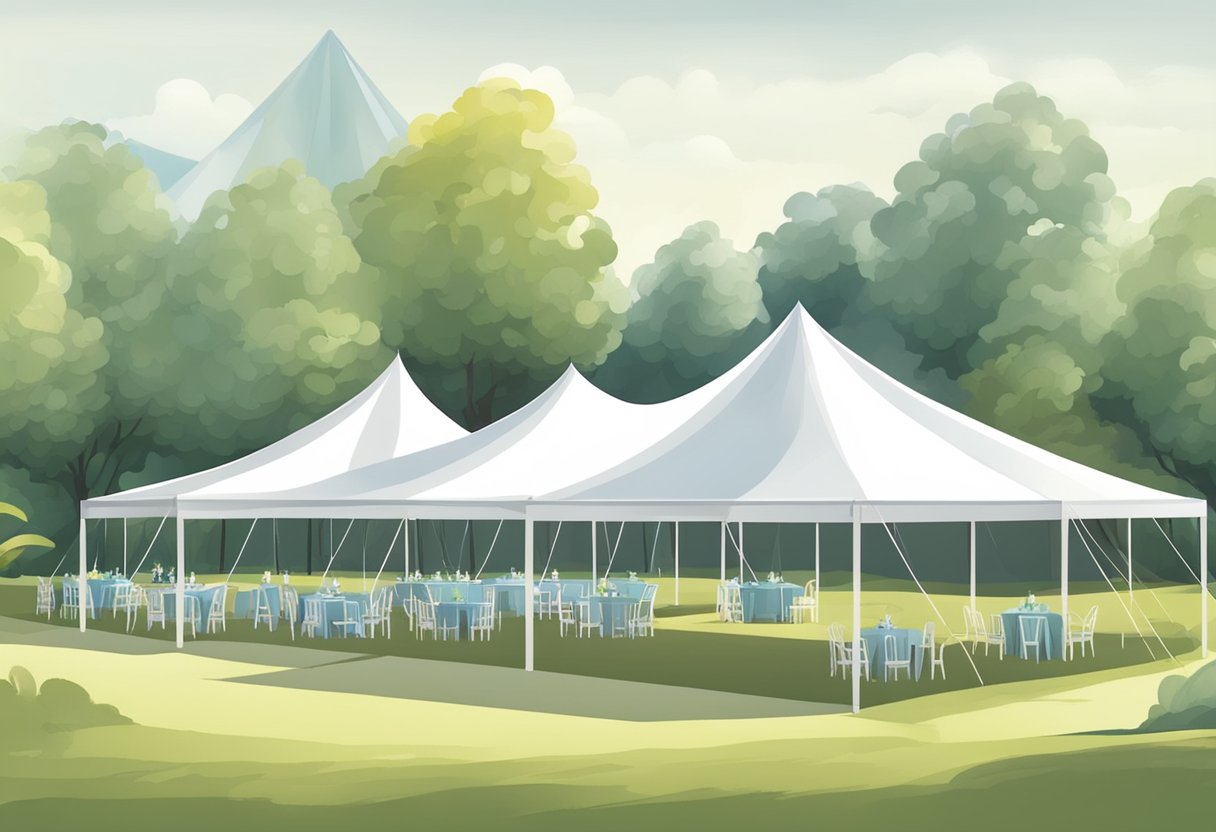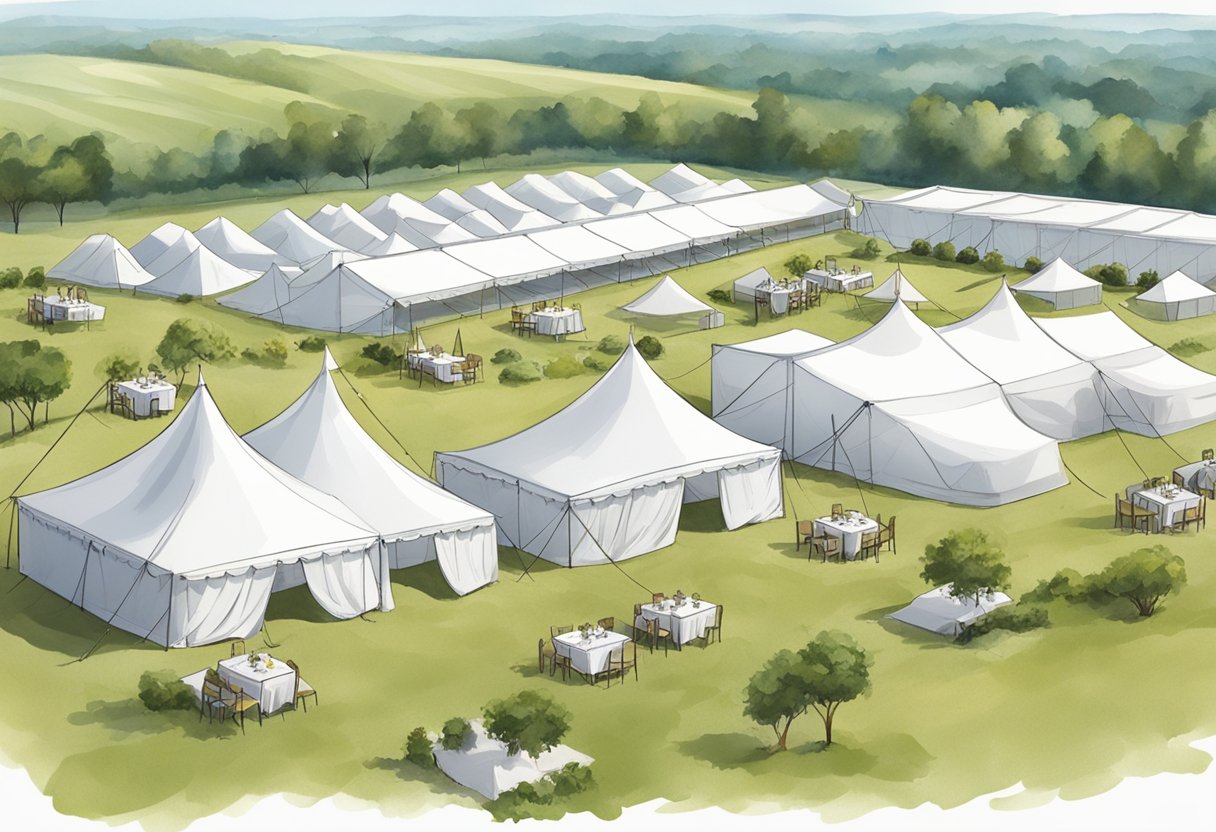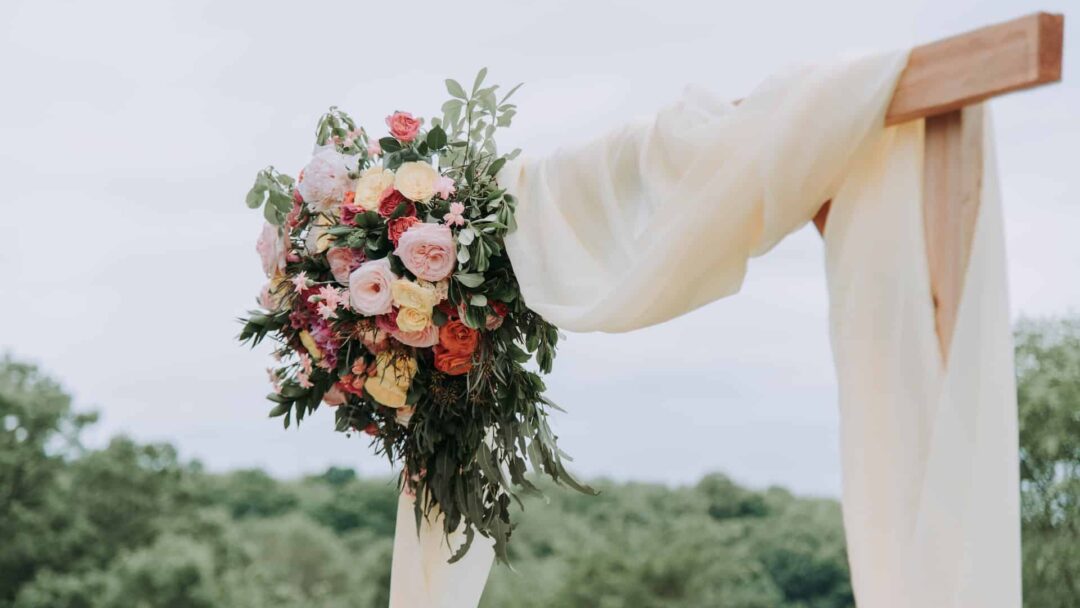Planning an outdoor event involves numerous considerations, one of which is choosing the right party tent size. A suitable tent not only protects guests from adverse weather conditions but also provides a comfortable space for the event to unfold seamlessly. It is essential to understand the various party tent sizes and styles available to make an informed decision that caters to the event’s needs and creates a welcoming ambiance for guests.

To make the selection process easier, it’s essential to determine the size and style of a party tent based on factors such as the number of guests, type of seating arrangement, and any additional space requirements. For example, a wedding with a seated dinner for 150 people might require a larger tent compared to a corporate event with theater-style seating. Additional space should be considered for elements such as a dance floor, buffet line, or stage.
Key Takeaways
- Choosing the right party tent size is crucial for a comfortable and successful outdoor event
- Consider factors like the number of guests, seating styles, and additional space requirements
- The appropriate tent size depends on the event type and specific needs
Understanding Party Tent Sizes

When planning an outdoor event, selecting the right party tent size is crucial to ensure a comfortable and enjoyable experience for your guests. There are various factors to consider when determining the appropriate tent size, including event type, number of attendees, and seating arrangements.
Party tent sizes typically range from small 10×10 or 10×20 tents for intimate gatherings, to large 100×200 tents or even bigger for massive events, such as music festivals or trade shows. Nevertheless, choosing a tent size solely based on the number of guests or event type may not be sufficient. It’s essential to take into account the different seating arrangements and spacing requirements that vary depending on the event.
For example, a wedding reception with a sit-down dinner will require a larger tent than a corporate event with theater-style seating. To ensure you choose the right tent size for your event, you can use a tent size calculator or refer to tent size charts provided by party rental companies. A tent size calculator takes into account your event type, number of guests, seating arrangement, and other factors such as space for a dance floor, bar, or buffet area to estimate the appropriate tent size needed.
In addition to considering the event-specific factors, it’s also important to account for the space available at the event venue. Make sure you measure the available area and compare it with the tent dimensions before finalizing the tent size. Keep in mind that some venues may require specific permits or have size restrictions due to fire codes or other regulations.
To summarize, understanding party tent sizes involves considering various factors such as event type, guest count, seating arrangement, and venue restrictions. Utilizing a tent size calculator or referring to tent size charts can help you estimate the most suitable tent size for your event, ensuring a comfortable and memorable experience for your guests.
Types Of Party Tents

Frame Tents
Frame tents are a popular choice for various events due to their versatility and ease of setup. They consist of a metal frame that supports the tent fabric, eliminating the need for central poles. This results in an open and unobstructed interior space, making frame tents an ideal option for events where maximum floor area is crucial.
The metal frames of these tents are usually made from aluminum or steel, providing strength and stability. Frame tents are easy to install on any surface, including grass, concrete, or asphalt, making them suitable for a wide range of venues. Their modular design allows for customization in size and shape, catering to events of different scales.
Additionally, frame tents offer the benefit of being able to withstand various weather conditions. The absence of central poles facilitates the attachment of optional sidewalls, providing added protection against wind, rain, or cold weather.
Pole Tents
Pole tents are characterized by their classic and elegant design, featuring one or more central poles and outwardly sloping sides supported by perimeter poles. The fabric is stretched over the poles and secured to the ground using stakes and ropes, creating a visually appealing setup perfect for weddings, festivals, and other celebratory events.
Pole tents typically offer more height in the center of the tent, creating a sense of spaciousness and grandeur. The sloping sides of the tent provide excellent water runoff in case of rain, and the high peak adds an element of style to the event.
It’s essential to consider that pole tents require a larger, relatively flat outdoor space, as their setup involves staking into the ground. Moreover, the presence of central poles may limit the interior layout, but this can be creatively worked around to create a unique and attractive event space.
In summary, both frame tents and pole tents cater to different needs and settings. Frame tents offer a versatile, unobstructed space for events, while pole tents provide a timeless, elegant aesthetic suitable for outdoor celebrations.
Size Determinants
Guest Count
The primary factor determining the size of a party tent is the total number of expected guests. It’s essential to choose a tent that can accommodate everyone comfortably without getting too stuffy or crowded. The more guests you expect, the larger the tent should be to ensure there is enough space for everyone to move around.
Seating Arrangements
Different seating arrangements require varying amounts of space. For instance, if guests will be seated ceremony-style (not at tables) or standing around cocktail tables, you will need a smaller tent compared to if they will be seated at tables. When planning your party tent size, consider the layout of your seating and how it will impact the overall space required.
Bar and Lounge Areas
In addition to accounting for guests and seating arrangements, you should consider any additional spaces or areas that will be part of your event, such as a bar or a lounge area. These features require extra space within the tent, and it is essential to factor their size and clearance room into your tent plans. Make sure there is enough space around these areas for both staff and guests to comfortably navigate.
Dance Floor
Including a dance floor in your event may significantly impact your tent size requirements. It is crucial to determine the desired dance floor size based on your guest count and the type of event you are hosting. Make sure you allocate sufficient space for the dance floor, as well as the surrounding area, to allow guests to comfortably mingle and enjoy the party.
Table Considerations
When planning an event with a party tent, one of the essential aspects to consider is the table layout. Tables play a significant role in determining the overall flow and guest experience of the event. In this section, we will discuss the types of tables and table sizes you may want to consider for your party tent.
Types of Tables
There are several types of tables that can be used in a party tent, depending on the event’s style and purpose. The most common types of tables include:
-
Round tables: Ideal for sit-down dinners, round tables encourage conversation among guests. They also provide an elegant and inviting atmosphere. Round tables come in various sizes depending on the number of guests per table.
-
Buffet tables: These tables are used for displaying food in a self-serve manner. They are usually long and rectangular, making them suitable for accommodating large quantities of dishes and allowing guests to easily access the food.
-
Cocktail tables: Also known as high-top tables, cocktail tables are tall and narrow, promoting mingling among guests during events with a standing or cocktail-style format.
Table Sizes
When selecting tables for your event, it’s crucial to consider the size of the tables, as different sizes will impact how many guests you can accommodate, and subsequently, the size of the party tent needed. The following common table sizes can help you determine which tables to use:
- 48-inch round table: Approximately 4 feet in diameter, this size comfortably seats 6 guests.
- 60-inch round table: With a diameter of 5 feet, this table most comfortably seats 8 guests but can fit up to 10.
- 72-inch round table: At 6 feet in diameter, this large-sized table can accommodate 10 to 12 guests.
- 6-foot buffet table: A standard long rectangular table typically measures 6 feet in length and 30 inches in width. It’s perfect for buffet-style setups or for long rows of guests.
- 8-foot buffet table: Similar to the 6-foot table, the 8-foot rectangular table provides additional space for food displays or guest seating.
Keep these table sizes and types in mind when planning your event to ensure a smooth and successful party tent experience. It’s important to remember that the right combination of tables can make a significant difference in the overall flow and atmosphere of your event.
Seating Styles and Capacities
When planning an event that requires a party tent, it is essential to consider the seating styles and capacities. Each seating style affects the required tent size differently and has unique advantages depending on the event.
Theater Style Seating
This seating style is ideal for events like ceremonies, presentations, or speeches. Theater-style seating involves arranging chairs in rows facing a focal point, such as a stage or podium, similar to a movie theater or auditorium. Seating capacity in this arrangement is generally more flexible compared to other styles.
For theater-style seating, allocate around 8 to 10 square feet per guest. Therefore, for an event with 100 guests:
- 20×40 tent (800 square feet) – 80 to 100 guests.
- 20×50 tent (1,000 square feet) – 100 to 125 guests.
Banquet Seating
Banquet seating typically involves arranging 6 to 8-foot long rectangular tables in parallel rows with chairs on each side. This seating style is suitable for events such as conferences, workshops, or informal dining. Usually, banquet seating can accommodate more people, but it may require more space.
For banquet seating, plan for:
- 10 to 12 square feet per guest.
- 2x the space as theater-style seating.
To calculate space requirements, if you have 100 attendees:
- 40×60 tent (2400 square feet) – 200 to 240 guests.
Sit-Down Dinner Seating
Sit-down dinner seating is characterized by arranging round tables with chairs around them. This seating style is perfect for formal dining events, such as weddings or gala dinners, and promotes conversation among attendees. However, it requires the most space compared to other seating styles.
For sit-down dinner seating, allocate:
- 15 to 20 square feet per guest.
- 2.5x the space as theater-style seating.
For an event with 400 guests:
- 40×100 tent (4000 square feet) – 200 to 267 guests.
Remember to consider additional space for elements like bars, buffet lines, stages, or dance floors that might be present within the tent.
Extra Space Considerations
When planning a party with a tent, it’s essential to account for extra space beyond just guest seating. Several factors can affect the overall space needed, such as a band stage, DJ booth, gift table, and vendor spaces. Carefully consider the following aspects to ensure a smooth flow and comfortable experience for everyone at your event.
Band Stage
A live band can elevate the atmosphere of your party, but it also requires a dedicated space within the tent. The stage’s size will depend on the number of musicians and their equipment needs, such as speakers, instruments, and lighting. Generally, bands require a minimum stage size of 8×12 feet. Speak with the band beforehand to accommodate their specific requirements and ensure a comfortable performance area.
DJ Booth
If you’re planning to have a DJ at your event, allocate a dedicated space for their booth. The DJ booth typically requires an area of 6×8 feet, depending on their equipment. Most DJ setups include speakers, a mixing table, and lighting equipment. Keep in mind the location of the dance floor, as the booth should be easily accessible to the DJ and close enough to create an engaging party atmosphere.
Gift Table
Incorporating a gift table is important to keep gifts organized and secure during the event. Sizes can vary, but a general guideline is to allocate approximately 8×8 feet of space for the gift table. Position the table in a noticeable yet unobtrusive area, preferably close to the entrance, making it convenient for guests to drop off their gifts while arriving.
Vendor Space
Events with vendors, such as food trucks, catering tables, or retail booths, will need additional space to accommodate their services. The space required may vary for each vendor type:
- Food trucks: Reserve an area of approximately 25×10 feet per truck, including space for queue lines.
- Catering tables: Allocate 10×15 feet for a catering station and additional space for food prep areas, if necessary.
- Retail booths: Plan for an area of around 10×10 feet per booth.
Taking these extra space considerations into account when planning your party tent sizes will ensure a comfortable and enjoyable experience for you, your guests, and any vendors or performers involved in your event.
Choosing the Right Tent for Your Event
Wedding Tent Sizes
Selecting the appropriate wedding tent size is vital for creating a comfortable environment for your guests. The size of the tent depends on the number of attendees and the type of seating arrangement. For instance, a 20×40 frame tent can accommodate 120 to 155 guests. When planning a wedding, it’s essential to consider the space needed for equipment, a dance floor, and other entertainment activities. In addition, factoring in buffet or seated dinner options will help determine the ideal tent size for your wedding.
Here are some general guidelines for wedding tent sizes:
- 60 guests: 20×20 ft tent
- 100 guests: 20×40 ft tent
- 150 guests: 30×40 ft tent
- 200 guests: 30×60 ft tent
Remember, these are rough estimates, and your specific needs may vary depending on the style of your wedding and additional space requirements.
Event Tent Sizes
When choosing a tent for other types of outdoor events, such as corporate gatherings or birthday parties, it’s crucial to consider the number of attendees, layout, and activities planned. Event tent sizes will depend on factors such as seating arrangements, entertainment, and the nature of the event.
For corporate events and meetings, you may need space for a stage, audio-visual equipment, and additional seating for presentations. Birthday parties or casual gatherings may require space for a buffet, a dance floor, or activities such as games and photobooths.
Here’s a general guide for event tent sizes:
- 50 guests: 20×20 ft tent
- 100 guests: 20×40 ft tent
- 150 guests: 30×40 ft tent
- 200 guests: 30×60 ft tent
- 300 guests: 40×80 ft tent
Keep in mind that these are just starting points, and you’ll want to adjust the tent size according to your event’s specific requirements to ensure comfort, ease of movement, and overall satisfaction for attendees.
Party Tent Rentals
When planning an outdoor event, choosing the right tent size is essential to ensure a comfortable and enjoyable experience for your guests. Party tent rentals come in various sizes and styles, making it easy to find the perfect fit for your event. In this section, we will discuss the different aspects of tent rentals, focusing on sizes suitable for different event types.
The size of the tent you need mainly depends on the number of guests and the event’s seating arrangement. For instance, a standing cocktail party requires less space per person compared to a seated dining arrangement. A general guideline is to allot 10 square feet per guest, although this may vary based on specific needs and event layouts.
A popular choice for medium-sized events, such as weddings or corporate receptions, is a 30×60 tent, which can accommodate around 150 guests in a ceremony-style seating arrangement or with cocktail tables. If your guests will be seated at tables, consider opting for a larger 40×60 tent.
Keep in mind that additional considerations, such as space for a buffet, bar, or stage, will require more square footage. Adjust the tent size accordingly to accommodate these features and ensure a comfortable layout for your event.
Here are some common tent sizes and their approximate guest capacities for different seating arrangements:
- 20×30 tent: up to 60 guests for seated dining, up to 100 guests for ceremony seating
- 20×40 tent: up to 80 guests for seated dining, up to 120 guests for ceremony seating
- 30×50 tent: up to 150 guests for seated dining, up to 200 guests for ceremony seating
- 30×60 tent: up to 180 guests for seated dining, up to 250 guests for ceremony seating
- 40×60 tent: up to 240 guests for seated dining, up to 300 guests for ceremony seating
Keep in mind that these are general guidelines, and the actual space requirements for your event may vary. When contacting an event rental company, provide them with detailed information about your event, such as the number of guests, type of seating arrangement, and any additional space requirements. This will help them recommend the most suitable tent size for your needs.
In conclusion, selecting the appropriate tent size for your event is crucial for ensuring guest comfort and a successful occasion. By carefully considering the number of attendees, seating arrangements, and additional space requirements, you can confidently choose the perfect party tent rental for your outdoor event.
Frequently Asked Questions
How many guests can a 20×20 tent accommodate?
A 20×20 tent can accommodate approximately 40 guests if they are seated at tables, or up to 67 guests for a standing room or cocktail setup. Make sure to keep in mind the type of event, seating arrangements, and additional equipment when determining your tent size.
Which tent size is suitable for 150 guests?
For 150 guests seated at tables, a tent size of approximately 30×60 or 40×40 is suitable. If your guests will be standing around cocktail tables or in a ceremony style, a smaller tent size may suffice. Always consider the event type, seating arrangements, and additional equipment when selecting the appropriate tent size.
What tent dimensions are needed for 100 guests and a dance floor?
In order to accommodate 100 guests and include a dance floor, a tent size of approximately 30×50 should be suitable. This will provide ample space for guests to be seated at tables while leaving room for a dance floor. Keep in mind any additional equipment or furnishings that may need to be placed under the tent.
What is the ideal tent size for 40 attendees?
For 40 attendees, a tent size of approximately 20×20 should be suitable if guests are seated at tables. If your guests will be standing around cocktail tables or in a ceremony style, a smaller tent size may suffice. Adjust the tent size based on the event type, seating arrangements, and additional equipment requirements.
How to calculate the tent size for an event?
To calculate the tent size for an event, consider the number of guests, the seating arrangement, and any additional equipment or furniture that will be placed under the tent. For guests seated at tables, allocate approximately 10-12 square feet per person. For standing room or cocktail setups, allocate around 6 square feet per person. Adjust the tent size as necessary based on your event needs.
What are common tent capacities for various sizes?
Some common tent capacities for various sizes are as follows:
- 10×20 tent: 20 seated guests or 33 standing guests
- 20×20 tent: 40 seated guests or 67 standing guests
- 20×30 tent: 60 seated guests or 100 standing guests
- 30×30 tent: 90 seated guests or 150 standing guests
- 30×50 tent: 150 seated guests or 250 standing guests
Remember to consider the event type, seating arrangements, and additional equipment when determining the tent capacity for different tent sizes.

